Comprehensive Guide to Spine Anatomy and Lower Back Problems
The spine is a complex anatomical structure made up of bones, joints, tendons, ligaments, muscles, nerves, and the spinal cord. A strong spinal column provides structure, support and flexibility to the human body. But a damaged spinal column can cause upper and lower back problems and conditions. Whether it’s back injury, wear and tear, or even invasive disease, back problems can range from nagging discomfort to severe pain – or worse.
Having a healthy back is essential for living life to the fullest. To help you discuss the spine conditions and treatment options with your surgeon, here’s a breakdown of the anatomy of the spine.
Guía Integral de la Anatomía de la Columna Vertebral y Problemas de la Espalda Baja
La columna vertebral es una estructura anatómica compleja compuesta por huesos, articulaciones, tendones, ligamentos, músculos, nervios y la médula espinal. Una columna fuerte proporciona estructura, soporte y flexibilidad al cuerpo humano. Pero una columna dañada puede causar problemas y afecciones en la parte superior e inferior de la espalda. Ya sea por una lesión, desgaste o incluso una enfermedad invasiva, los problemas de espalda pueden variar desde una molestia persistente hasta un dolor intenso, o peor.
Tener una espalda saludable es esencial para vivir la vida al máximo. Para ayudarle a conversar con su cirujano sobre las condiciones de la columna y las opciones de tratamiento, aquí tiene un desglose de la anatomía de la columna vertebral.
- AnatomyAnatomía
- Conditions Condiciones
- Procedures Cirugías
Spine Anatomy
The spine, also called the backbone, provides stability and smooth movement, as well as protection for the spinal cord. The spine is made of vertebral bones with cushioning intervertebral discs between them, which are supported by muscles, tendons and ligaments, and innervated by nerves within the spinal cord.
Vertebra
The spine is a column from your head to your pelvis made up of approximately 33 bony segments called vertebrae, and fibrous tissue called intervertebral discs.
Twenty four vertebrae articulate with each other, while the last nine are fused together. Each vertebra is made up of several parts:
Vertebral body
Supports most of the load while standing and provides a platform for the attachment of the intervertebral discs.
Pedicles
Are two cylinder-shaped projections originating from the back of the vertebral body, connecting the front and back of the vertebra.
Lamina
Are a pair of flat arched bones that form the roof of the spinal canal, and provide support and protection.
Spinous processes
Are the bony projections that arise at right angles to the midline of the lamina, and can be felt when touching the back.
Transverse processes
Are bony protrusions located at the junction of the pedicle and lamina, and are where the back muscles are attached
Spinal canal
Is the tunnel formed at the center of the vertebra for the passage of the spinal cord.
Facet joints
Are paired articular processes found at the vertebral arch, and consist of superior facets, which articulate with the vertebra above and the inferior facets, which articulate to the vertebra below.
Intervertebral discs
The intervertebral discs are flat, rounded soft tissue structures situated between two vertebral bodies of the spine that function as shock absorbers. The discs are composed of a tough, fibrous outer ring called the annulus fibrosus and a soft, inner core called the nucleus pulposus.
Vertebral column
The vertebrae are arranged one on top of the other to form the spine. The spine is categorized into five spinal segments:
The cervical spine is the neck, and begins at the base of the skull and is composed of seven vertebrae, numbered C1 to C7. The neck supports the head and allows the greatest range of motion due to two specially shaped vertebrae.
The thoracic spine is made up of twelve thoracic vertebrae that start from the upper chest and extend to the middle back numbered T1 to T12. They communicate with the ribs in the front of the chest to protect the heart and lungs.
The lumbar spine is made up of five lumbar vertebrae in the lower back region, numbered L1 to L5. These. They are larger in size in order to carry the body’s weight, and absorb the stress of lifting and carrying.
The sacrum is a single bone, formed by the fusion of five sacral vertebrae and connects the spine to the hip bones.
The Coccyx is the tailbone, and is formed from the fusion of four bones in order to provide attachment for muscles and ligaments to the pelvic floor.
Spinal curves
The adult spine resembles a natural S-shaped curve, which provides strength and support to the spine, maintains balance, and absorbs shock.
Muscles of the Spine
The extensors, flexors and oblique muscles stabilize the spine and allow the spine to move.
The extensor muscles are attached to the back of the spine and help with standing and lifting.
The flexor muscles originate from the front of the spine and include the muscles of the abdomen, in order to help with forward movement, lifting, and controlling the lower back.
The oblique muscles are found at the sides of the body and help in the side-ways rotation of the back.
Ligaments of the Spine
Spinal ligaments are strong fibrous bands that stabilize and hold the vertebrae in place. The ligamentum flavum attaches the lamina to each other. The anterior longitudinal ligament and posterior longitudinal ligament are continuous bands that run from the top to the bottom of the spinal column along the vertebral bodies.
Spinal cord
The spinal cord starts in the brain and extends through the base of the skull to the lower back through the spinal canal. It is covered by three membranes called meninges. Spaces between these membranes are filled with cerebrospinal fluid.
There are 31 pairs of spinal nerves that originate from the spinal cord. These nerves carry all the information from the body to the brain, controlling sensation and movement. Any damage or injury to the spinal cord can cause loss of sensation or function to the part of the body.
Never turn your back on your back – give your spine the care and attention it deserves. If you’re suffering from back injuries, problems, or conditions, see how we can help you get your life back.
Anatomía de la Columna Vertebral
La columna vertebral, también llamada espina dorsal, proporciona estabilidad y movimiento suave, así como protección para la médula espinal. La columna está formada por huesos vertebrales con discos intervertebrales amortiguadores entre ellos, los cuales están sostenidos por músculos, tendones y ligamentos, e inervados por nervios dentro de la médula espinal.
Vértebra
La columna es una columna que va desde la cabeza hasta la pelvis compuesta por aproximadamente 33 segmentos óseos llamados vértebras y tejido fibroso llamado discos intervertebrales. Veinticuatro vértebras se articulan entre sí, mientras que las últimas nueve están fusionadas. Cada vértebra está formada por varias partes:
- Cuerpo vertebral Soporta la mayor parte de la carga al estar de pie y proporciona una plataforma para la unión de los discos intervertebrales.
- Pedículos Son dos proyecciones en forma de cilindro que se originan en la parte posterior del cuerpo vertebral, conectando la parte frontal y posterior de la vértebra.
- Láminas Son un par de huesos planos y arqueados que forman el techo del canal espinal y proporcionan soporte y protección.
- Apófisis espinosas Son las proyecciones óseas que surgen en ángulos rectos hacia la línea media de la lámina y se pueden palpar al tocar la espalda.
- Apófisis transversas Son protrusiones óseas ubicadas en la unión del pedículo y la lámina, y son el lugar donde se insertan los músculos de la espalda.
- Canal espinal Es el túnel formado en el centro de la vértebra para el paso de la médula espinal.
- Articulaciones facetarias Son procesos articulares pares que se encuentran en el arco vertebral y consisten en facetas superiores, que se articulan con la vértebra superior, y facetas inferiores, que se articulan con la vértebra inferior.
Discos intervertebrales
Los discos intervertebrales son estructuras de tejido blando, planas y redondeadas, situadas entre dos cuerpos vertebrales de la columna que funcionan como amortiguadores. Los discos están compuestos por un anillo externo resistente y fibroso llamado anillo fibroso y un núcleo interno blando llamado núcleo pulposo.
Columna vertebral
Las vértebras están dispuestas una encima de la otra para formar la columna. La columna se clasifica en cinco segmentos:
- La columna cervical es el cuello y comienza en la base del cráneo y está compuesta por siete vértebras, numeradas de C1 a C7. El cuello sostiene la cabeza y permite el mayor rango de movimiento gracias a dos vértebras con forma especial.
- La columna torácica está formada por doce vértebras torácicas que comienzan en la parte superior del pecho y se extienden hasta la parte media de la espalda, numeradas de T1 a T12. Se comunican con las costillas en la parte frontal del pecho para proteger el corazón y los pulmones.
- La columna lumbar está formada por cinco vértebras lumbares en la región baja de la espalda, numeradas de L1 a L5. Estas son más grandes en tamaño para soportar el peso del cuerpo y absorber el esfuerzo de levantar y cargar.
- El sacro es un hueso único, formado por la fusión de cinco vértebras sacras y conecta la columna con los huesos de la cadera.
- El cóccix es el hueso de la cola y se forma a partir de la fusión de cuatro huesos para proporcionar la unión de músculos y ligamentos al suelo pélvico.
Curvaturas de la columna
La columna adulta se asemeja a una curva natural en forma de S, lo que proporciona fuerza y soporte a la columna, mantiene el equilibrio y absorbe impactos.
Músculos de la columna
Los músculos extensores, flexores y oblicuos estabilizan la columna y permiten su movimiento. Los músculos extensores están unidos a la parte posterior de la columna y ayudan a estar de pie y levantar objetos. Los músculos flexores se originan en la parte frontal de la columna e incluyen los músculos del abdomen para ayudar en el movimiento hacia adelante, levantar y controlar la parte baja de la espalda. Los músculos oblicuos se encuentran en los lados del cuerpo y ayudan en la rotación lateral de la espalda.
Ligamentos de la columna
Los ligamentos espinales son bandas fibrosas fuertes que estabilizan y mantienen las vértebras en su lugar. El ligamento amarillo une las láminas entre sí. El ligamento longitudinal anterior y el ligamento longitudinal posterior son bandas continuas que van desde la parte superior hasta la inferior de la columna a lo largo de los cuerpos vertebrales.
Médula espinal
La médula espinal comienza en el cerebro y se extiende desde la base del cráneo hasta la parte baja de la espalda a través del canal espinal. Está cubierta por tres membranas llamadas meninges. Los espacios entre estas membranas están llenos de líquido cefalorraquídeo. Existen 31 pares de nervios espinales que se originan en la médula espinal. Estos nervios transportan toda la información del cuerpo al cerebro, controlando la sensibilidad y el movimiento. Cualquier daño o lesión en la médula espinal puede causar pérdida de sensibilidad o función en la parte del cuerpo afectada.
Nunca le des la espalda a tu espalda: dale a tu columna el cuidado y la atención que merece. Si sufres de lesiones, problemas o afecciones en la espalda, descubre cómo podemos ayudarte a recuperar tu vida.
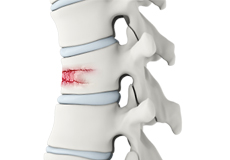
Spinal Compression Fractures
A compression fracture of the vertebra occurs when the bones of the spine (vertebrae) collapse. Most commonly, these fractures occur in the thoracic or the middle portion of the spine.
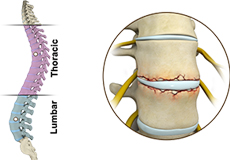
Fracture of the Thoracic and Lumbar Spine
The backbone is made of small bones arranged from the neck down to the buttocks, one above the other. The region at the chest and lower back are called the thoracic and lumbar spine, respectively. These are the two regions commonly affected by a fracture.
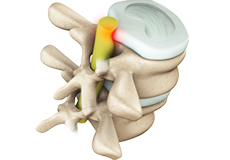
Lumbar Radiculopathy
The spine consists of 33 vertebral bones stacked one on top of the other with cushioning discs lying between each vertebra. The lumbar region of the spine (below the rib cage) consists of 5 vertebrae.
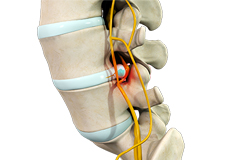
Lumbar Stenosis
Lumbar stenosis is the compression of spinal nerves caused by the narrowing of the spinal canal. It is one of the common causes of lower back pain. Spinal stenosis can also affect the spine in the neck region.

Lumbar Disc Herniation
The lumbar intervertebral discs are flat and round, present between the lumbar vertebrae and act as shock absorbers when you walk or run.
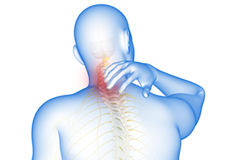
Cervical Spondylosis
Cervical spondylosis, also called arthritis of the neck, is an age-related medical condition characterized by deterioration of spinal joints, vertebrae, discs, and ligaments in your neck.
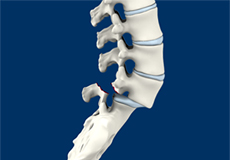
Spondylolisthesis
Spondylolisthesis is the displacement of the vertebral disc from the spinal column. Outward (forward) displacement is termed as anterolisthesis and inward (backward) displacement is termed as retrolisthesis.

Sciatica
The sciatic nerve is the longest nerve in your body. It begins in the lower back and extends through the buttocks down the back of each leg to the thighs and feet.
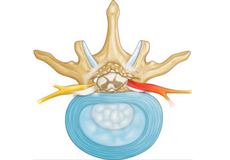
Cervical Radiculopathy/Myelopathy
The spine, also called the backbone, is designed to give us stability, smooth movement, as well as provide a corridor of protection for the delicate spinal cord. It is made up of bony segments called vertebrae and fibrous tissue called intervertebral discs.

Cervical Stenosis
Cervical stenosis refers to the narrowing of the spinal canal that protects the spinal cord and its branching nerves.
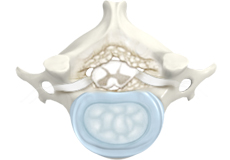
Cervical Degenerative Disorder
The intervertebral disc is composed of an inflexible ring called the annulus fibrosis which encloses a gelatinous inner structure called the nucleus pulposus.

Spinal Stenosis
Spinal stenosis is a condition caused by the vertebral column constricting and exerting pressure on the spinal cord or neural foramen (a bony tunnel through which a nerve exits the spinal cord).
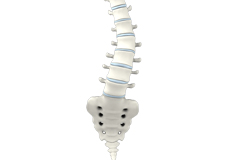
Adult Degenerative Scoliosis
Adult degenerative scoliosis is characterized by side to side or lateral bending of the spine in adults. Degenerative scoliosis can involve either the mid-back and/or lower back region of the spine.

Low Back Pain
Low back pain is often a common symptom of many disease conditions and the back pain may range from simple or dull pain to sudden and sharp pain.

Cervical Disc Herniation
Cervical disc herniation can arise due to aberrations of the intervertebral disc such as bulging, rupture, and slipped or extruded disc. It results in neck, shoulder, and arm pain.
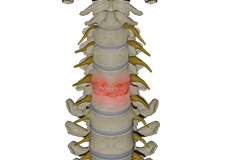
Cervical Degenerative Disc Disease
Cervical degenerative disc disease (DDD) is a misnomer, as it is not a disease as such but a condition that affects the strength, resiliency and structural integrity of the intervertebral discs due to increasing age, trauma, injury, repetitive movement, improper posture, or poor body mechanics.

Fracturas por Compresión Espinal
Una fractura por compresión de la vértebra ocurre cuando los huesos de la columna (vértebras) colapsan. Con mayor frecuencia, estas fracturas ocurren en la columna torácica o en la parte media de la columna.

Fractura de la Columna Torácica y Lumbar
La columna vertebral está formada por pequeños huesos dispuestos desde el cuello hasta los glúteos, uno encima del otro. La región del pecho y la parte baja de la espalda se denominan columna torácica y lumbar, respectivamente. Estas son las dos regiones que se ven comúnmente afectadas por una fractura.

Radiculopatía Lumbar
La columna vertebral consta de 33 huesos vertebrales apilados uno encima del otro con discos amortiguadores situados entre cada vértebra. La región lumbar de la columna (debajo de la caja torácica) consta de 5 vértebras. Los nervios de la médula espinal en esta región se comunican con la parte inferior del cuerpo a través de espacios entre las vértebras.

Estenosis Lumbar
Para ayudarle a discutir los síntomas y las opciones de tratamiento para la estenosis lumbar con su cirujano ortopédico, aquí tiene un desglose de esta condición.

Hernia de Disco Lumbar
Los discos intervertebrales lumbares son planos y redondos, están presentes entre las vértebras lumbares y actúan como amortiguadores cuando camina o corre.

Espondilosis Cervical
La espondilosis cervical, también llamada artritis del cuello, es una condición médica relacionada con la edad caracterizada por el deterioro de las articulaciones espinales, vértebras, discos y ligamentos en el cuello.

Espondilolistesis
La espondilolistesis es el desplazamiento del disco vertebral desde la columna vertebral. El desplazamiento hacia afuera (hacia adelante) se denomina anterolistesis y el desplazamiento hacia adentro (hacia atrás) se denomina retrolistesis.

Ciática
La ciática es causada por la irritación del nervio ciático, el nervio más largo de su cuerpo que se extiende desde la parte baja de la espalda hasta los muslos y pies.

Radiculopatía y Mielopatía Cervical
Para ayudarle a discutir los síntomas y las opciones de tratamiento de la radiculopatía y mielopatía cervical con su cirujano ortopédico, aquí tiene un desglose de estas condiciones.

Estenosis Cervical
La estenosis cervical se refiere al estrechamiento del canal espinal que protege la médula espinal y sus nervios ramificados.

Trastorno Degenerativo Cervical
La enfermedad degenerativa del disco cervical (DDD, por sus siglas en inglés) es un término incorrecto, ya que no es una enfermedad sino una condición que afecta la fuerza, la resiliencia y la integridad estructural de los discos intervertebrales debido al envejecimiento, trauma, lesión, movimientos repetitivos, postura inadecuada o mala mecánica corporal.

Estenosis Espinal
La estenosis espinal ocurre cuando la columna vertebral se estrecha y ejerce presión sobre la médula espinal o el foramen neural. La estenosis central cervical/lumbar ocurre cuando el canal espinal está estrechado.

Escoliosis Degenerativa en Adultos
La escoliosis degenerativa en adultos se caracteriza por la curvatura lateral o de lado a lado de la columna vertebral en adultos. La escoliosis degenerativa puede involucrar la región media de la espalda y/o la región lumbar de la columna.

Dolor Lumbar
El dolor lumbar es a menudo un síntoma común de muchas enfermedades y el dolor puede variar desde un dolor simple o sordo hasta un dolor repentino y agudo.

Hernia de Disco Cervical
Para ayudarle a hablar sobre los síntomas y las opciones de tratamiento de la hernia de disco cervical con su cirujano ortopédico, aquí tiene un desglose de esta condición.

Enfermedad Degenerativa del Disco Cervical
Para ayudarle a hablar sobre los síntomas y opciones de tratamiento de la enfermedad degenerativa del disco cervical con su cirujano ortopédico, aquí tiene un desglose de esta condición.
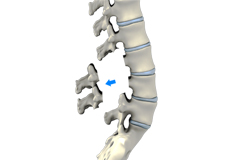
Lumbar Laminectomy
Lumbar laminectomy is a spinal surgery to relieve excess pressure on the spinal cord or nerves within the spinal canal in the lumbar or lower back region.
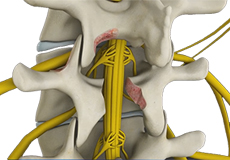
Lumbar Decompression
The spinal cord is protected by a bony column of vertebral bones, arranged one above the other. Injury or wear-and-tear can cause parts of the vertebrae to compress the nerves of the spinal cord, leading to pain, numbness or tingling in the part of the body that the nerve supplies.
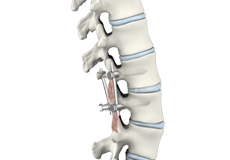
Transforaminal Lumbar Interbody Fusion (TLIF)
Transforaminal lumbar interbody fusion (TLIF) is a type of spinal fusion procedure in which bone graft is placed between the affected vertebrae in the lower back (lumbar) region through an incision on the patient's back.
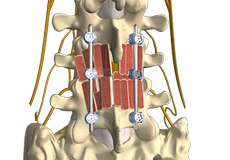
Posterolateral Lumbar Fusion
Posterolateral lumbar fusion is a surgical technique that involves correcting spinal problems from the back of the spine by placing bone graft between segments in the back and leaving the disc space intact.

Lateral Lumbar Interbody Fusion
The back is made up of a number of small bones called vertebrae. Cushioning discs present between the vertebrae act as shock absorbers.

Lumbar Interbody Fusion
Lumbar interbody fusion (LIF) surgery is a surgical technique that involves the removal of a damaged intervertebral disc and the insertion of a bone graft into the disc space created between the two adjoining vertebrae.
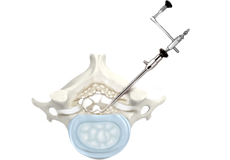
Posterior Cervical Microforaminotomy/Discectomy
Posterior cervical microforaminotomy/discectomy is an operative procedure that relieves pressure or compression on the nerve roots at the cervical spine.
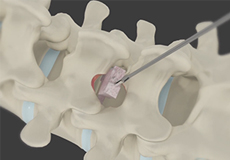
Minimally Invasive Lumbar Discectomy
Lumbar discectomy is a spinal surgery that involves the removal of the damaged intervertebral disc(s) to relieve pressure on the spinal nerves (decompression) in the lumbar (lower back) region, which forms the lower portion of the spine and comprises of five vertebrae (L1-L5). A minimally invasive technique is implemented to perform the surgery.
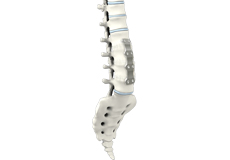
Anterior Lumbar Interbody Fusion
Anterior lumbar interbody fusion (ALIF) is a surgery performed to correct spinal problems in the lower back. The surgery can be implemented either as an open surgery or minimally invasive technique.

Kyphoplasty
Osteoporosis (bone disease) is the primary cause of vertebral compression fractures. Other causes include trauma such as a fall or motor vehicle accident and some types of cancers affecting the spinal vertebrae.

Minimally Invasive Spine Surgery
Minimally invasive spine surgery (MISS) is the latest technology available to perform spinal surgeries through small, less than one-inch-long incisions.
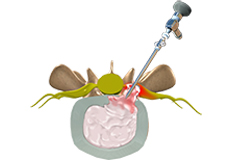
Lumbar Microdiscectomy
Microdiscectomy is a surgical procedure employed to relieve the pressure over the spinal cord and/or nerve roots, caused by a ruptured (herniated) intervertebral disc.
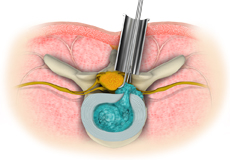
Microscopic Spine Surgery
Microscopic spine surgery is a minimally invasive surgical procedure performed using state-of-the-art technology to treat conditions pertaining to the spine
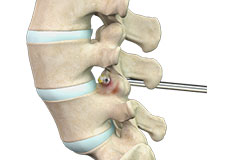
Degenerative Spine Surgery
Degenerative spine surgery includes surgical procedures to treat degenerative spine conditions such as disc disease and spinal stenosis that can result in the gradual deterioration of the spine with pain and loss of function.

Robotic Spine Surgery
Robotic spine surgery is a procedure where your surgeon is assisted by a robotic system to perform surgery to the spine. Precision is very important when performing spine surgery.

Posterior Cervical Laminectomy and Fusion
Injury or wear-and-tear can cause parts of the cervical vertebrae in the neck region to compress the nerves of the spinal cord, leading to pain, numbness, or tingling in the part of the body that the nerve supplies.
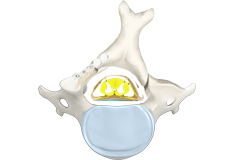
Cervical Laminoplasty
Degeneration of the facet joints and intervertebral discs that connect vertebrae to one another results in narrowing of the spinal canal, known as spinal stenosis. In addition, the arthritic facet joints become bulkier and consume the space existing for the nerve roots.
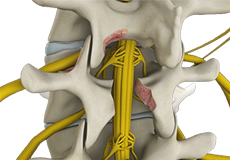
Minimally Invasive Lumbar Decompression
Minimally invasive lumbar decompression or mild® is a procedure developed by Vertos Medical to treat lumbar spinal stenosis by relieving pressure on the spinal nerves.
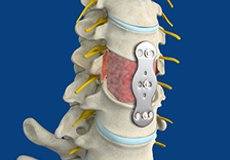
Anterior Cervical Corpectomy and Fusion
An anterior cervical corpectomy and fusion is an operative procedure to relieve pressure on the spinal cord and spinal nerves by removing the vertebral bone and intervertebral disc material (decompression) in the cervical spine or neck.
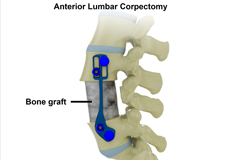
Anterior Lumbar Corpectomy and Fusion
Anterior Lumbar Corpectomy and Fusion is a surgical technique performed to remove the vertebral bone or disc material between the vertebrae to alleviate pressure on the spinal cord and spinal nerves (decompression) in the lumbar (lower back) region.

Minimally Invasive Cervical Discectomy
The vertebrae of the backbone are cushioned by intervertebral discs that act as shock absorbers and allow frictionless movement of your back. It is made up of a soft gel-like center called the nucleus pulposus that is surrounded by a tough outer ring of annulus fibrosus
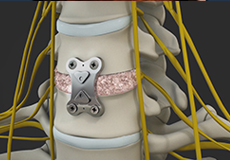
Anterior Cervical Discectomy with Fusion
The vertebrae of the backbone are cushioned by intervertebral discs that act as shock absorbers and allow frictionless movement of your back.
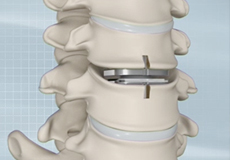
Cervical Disc Replacement
The cervical spine is located in the neck region and consists of seven bones arranged one on top of the other. Cushioning tissue called vertebral discs located between the vertebrae act as shock absorbers, allowing easy movement of the neck.
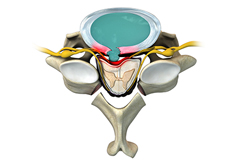
Cervical Laminectomy and Fusion
Cervical laminectomy is a surgical procedure in which the spinal canal is made larger by removing the spinous process and the lamina in the cervical region of the spine.

Laminectomía Lumbar
Para ayudarle a hablar sobre la cirugía de laminectomía lumbar como una opción de tratamiento con su cirujano ortopédico, aquí tiene un desglose de este procedimiento quirúrgico.

Descompresión Lumbar
La médula espinal está protegida por una columna ósea de vértebras, dispuestas una encima de la otra. Una lesión o el desgaste pueden hacer que partes de las vértebras compriman los nervios de la médula espinal, lo que provoca dolor, entumecimiento u hormigueo en la parte del cuerpo que inerva el nervio.

Fusión Intervertebral Lumbar Transforaminal (TLIF)
La fusión intervertebral lumbar transforaminal (TLIF) es un tipo de procedimiento de fusión espinal en el que se coloca un injerto óseo entre las vértebras afectadas en la región lumbar (parte baja de la espalda) a través de una incisión en la espalda del paciente.

Fusión Lumbar Posterolateral
Para ayudarle a conversar sobre la cirugía de fusión lumbar posterolateral como opción de tratamiento con su cirujano ortopédico, aquí tiene un desglose de este procedimiento quirúrgico.

Fusión Lumbar Intercorporal Lateral
La espalda está compuesta por una serie de pequeños huesos llamados vértebras. Los discos de amortiguación presentes entre las vértebras actúan como amortiguadores.

Fusión Intersomática Lumbar
La cirugía de fusión intersomática lumbar (LIF, por sus siglas en inglés) es una técnica quirúrgica que implica la remoción de un disco intervertebral dañado y la inserción de un injerto óseo en el espacio discal creado entre dos vértebras adyacentes.

Microforaminotomía/Discectomía Cervical Posterior
La microforaminotomía/discectomía cervical posterior es un procedimiento quirúrgico que alivia la presión o compresión sobre las raíces nerviosas en la columna cervical. La región cervical (área del cuello) forma la parte superior de la columna.

Discectomía Lumbar Mínimamente Invasiva
La discectomía lumbar es una cirugía de columna que implica la remoción del/los disco(s) intervertebral(es) dañado(s) para aliviar la presión sobre los nervios espinales (descompresión) en la región lumbar (parte baja de la espalda), que forma la porción inferior de la columna y está compuesta por cinco vértebras (L1-L5). Se implementa una técnica mínimamente invasiva para realizar la cirugía.

Fusión Intersomática Lumbar Anterior
La fusión intersomática lumbar anterior (ALIF, por sus siglas en inglés) es una cirugía realizada para corregir problemas de la columna en la parte baja de la espalda. La cirugía puede implementarse ya sea como cirugía abierta o mediante una técnica mínimamente invasiva.

Cifoplastia
La osteoporosis (enfermedad ósea) es la causa principal de las fracturas por compresión vertebral. Otras causas incluyen traumatismos como caídas o accidentes de tránsito y algunos tipos de cáncer que afectan las vértebras de la columna.

Cirugía de Columna Mínimamente Invasiva
La cirugía de columna mínimamente invasiva (MISS, por sus siglas en inglés) es la tecnología más reciente disponible para realizar cirugías de columna a través de incisiones pequeñas, de menos de una pulgada de longitud.

Microdiscectomía Lumbar
La microdiscectomía es un procedimiento quirúrgico empleado para aliviar la presión sobre la médula espinal y/o las raíces nerviosas, causada por un disco intervertebral roto (herniado).

Cirugía Microscópica de Columna
La cirugía microscópica de columna es un procedimiento quirúrgico mínimamente invasivo realizado utilizando tecnología de última generación para tratar condiciones relacionadas con la columna vertebral.

Cirugía de Columna Degenerativa
La cirugía de columna degenerativa incluye procedimientos quirúrgicos para tratar condiciones degenerativas de la columna, como la enfermedad de los discos y la estenosis espinal, que pueden resultar en el deterioro gradual de la columna con dolor y pérdida de función.

Cirugía Robótica de Columna
La cirugía robótica de columna es un procedimiento en el que su cirujano es asistido por un sistema robótico para realizar cirugía en la columna. La precisión es muy importante al realizar cirugía de columna.

Laminectomía y Fusión Cervical Posterior
Para ayudarle a discutir la laminectomía y fusión cervical posterior como una opción de tratamiento con su cirujano ortopédico, aquí tiene un desglose de este procedimiento quirúrgico.

Laminoplastia Cervical
La degeneración de las articulaciones facetarias y de los discos intervertebrales que conectan las vértebras entre sí resulta en el estrechamiento del canal espinal, conocido como estenosis espinal. Además, las articulaciones facetarias artríticas se vuelven más voluminosas y ocupan el espacio existente para las raíces nerviosas.

Descompresión Lumbar Mínimamente Invasiva
La descompresión lumbar mínimamente invasiva o MILD® es un procedimiento desarrollado por Vertos Medical para tratar la estenosis espinal lumbar al aliviar la presión sobre los nervios espinales.

Corpectomía y Fusión Cervical Anterior
La corpectomía y fusión cervical anterior es un procedimiento quirúrgico para aliviar la presión sobre la médula espinal y los nervios espinales mediante la remoción del hueso vertebral y del material del disco intervertebral (descompresión) en la columna cervical o cuello.

Corpectomía y Fusión Lumbar Anterior
La corpectomía y fusión lumbar anterior es una técnica quirúrgica realizada para remover el hueso vertebral o el material del disco entre las vértebras para aliviar la presión sobre la médula espinal y los nervios espinales (descompresión) en la región lumbar (parte baja de la espalda).

Discectomía Cervical Mínimamente Invasiva
Las vértebras de la columna están amortiguadas por discos intervertebrales que actúan como absorbentes de impactos y permiten un movimiento sin fricción de la espalda. Están compuestos por un núcleo blando similar a un gel llamado núcleo pulposo, rodeado por un anillo exterior resistente llamado anillo fibroso (anulus fibrosus).

Discectomía Cervical Anterior con Fusión
Las vértebras de la columna están amortiguadas por discos intervertebrales que actúan como absorbentes de impactos y permiten un movimiento sin fricción de la espalda.

Reemplazo de Disco Cervical
La columna cervical se encuentra en la región del cuello y está formada por siete huesos dispuestos uno sobre otro. El tejido amortiguador llamado discos vertebrales, ubicado entre las vértebras, actúa como absorbente de impactos, permitiendo un movimiento fácil del cuello.

Laminectomía y Fusión Cervical
La laminectomía cervical es un procedimiento quirúrgico en el cual se amplía el canal espinal mediante la remoción del proceso espinoso y la lámina en la región cervical de la columna.
